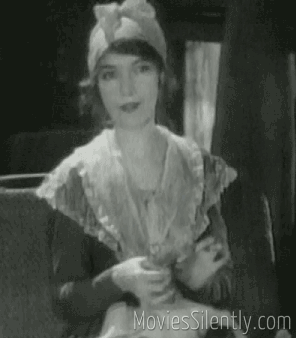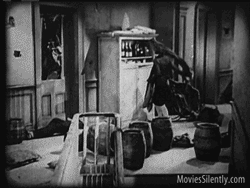Readers of this site know that I get more than a little annoyed when silent film heroines are dismissed as screaming damsels tied to the tracks. Not only is this a myth, it is a damaging one, erasing the many bold and brash silent movie heroines from film history.
In my discussions of women in silent films, I find myself coming back again and again to certain terms. I wanted to share four of them with you today.
A few quick clarifications before getting started:
- I am not arguing that the silent era was a feminist utopia. I am merely sharing the fact that there were many juicy and empowered roles for women, likely due to the fact that half the movies were written by women. In fact, I dare say the proportion of damsels in silent cinema is on par with what we see today.
- I am going to be using Mary Pickford A LOT as an example because she is awesome and her heroines are awesome.
- You can critique the media you love. It’s okay. It doesn’t mean you hate it. Contrariwise, liking entertainment with problematic elements doesn’t make you a big ol’ sexist. I love the heck out of The Sheik, which is, um, well, it has issues. That’s okay. We’re being academic here.
Agency
There are many definitions of agency floating around but when I use the term, this is what I mean:
A character who has agency is one who takes control of his or her situation as far as is possible at the time.
What makes a damsel-in-distress so frustrating is that she basically gives up and fails to take the opportunities for action that a male character would have almost certainly taken in her place. For example, we expect a male hero to fight until he is overpowered by numbers or superior weapons but a woman is frequently subdued by a hand resting on her upper arm.

My go-to example of the difference between a damsel and a hero is James Bond. Over his fifty-plus year career, Mr. Bond has been kidnapped, overpowered, tortured, threatened with death and dismemberment and generally knocked about. However, even in situations where he is helpless, he is portrayed as dangerous and competent, always looking for an opportunity for escape. He may be rescued by other characters at times but he is always made to be the hero in the end, taking the lead in saving the world. Not only does he have agency, the film focuses on his struggles and perils as a way of illustrating his grit and determination.
There is a notion that objecting to movie damsels means that we never want to see a woman imperiled on the screen. That’s simply not true. As we can see from the examples above, men are constantly imperiled in films, it’s how they are allowed to deal with that peril that makes the difference.

In Sparrows, Mary Pickford is in the care of foster parents from hell. When the villains decide to supplement their income by kidnapping a wealthy baby, Pickford springs into action. The police and the baby’s father are in evidence but she doesn’t sit around waiting to be rescued. Instead, she shepherds a gaggle of children through a dangerous swamp and saves the day through her own bravery. Was she imperiled? Yes. Did she give up? Never! Was her peril used to build up the heroism of a male character? Absolutely not!
The Bechdel Test
This test was invented by cartoonist Alison Bechdel and it asks three simple questions:
- Is there more than one woman in this movie with a name?
- Do they talk to each other?
- Do they talk about something other than a man?
Many people misunderstand this test. It’s not a measure of whether or not an individual movie is good or bad or sexist. These three questions represent a ridiculously low bar and the fact that so few modern Hollywood films pass the test is the point. It’s meant to illuminate the state of women in movies as a whole.

That being said, I do add my own variation to the third question: “Do they talk about something other than a man or cliched and traditionally feminine topics?” That is, do they avoid talking about men but discuss only nail polish, babies, baking and baubles? Nothing wrong with these topics, of course, but if these things are all the women in films discuss, we have a problem.
The 1918 Mary Pickford vehicle Stella Maris is a great example of the focus on women in the silent era. Not only does it pass the Bechdel test with flying colors, it fails the reverse Bechdel test. That is, there are multiple men with names in the cast but all their conversations are with or center around the women. Further, women drive the plot and make the tough decisions while the male lead is tied up in emotional knots.
The Sexy Lamp Test
Invented by Kelly Sue DeConnick, the Sexy Lamp Test asks one question:
Could the female character be replaced by a sexy lamp?
This test works well for the “Give us all our daughters back” genre of action movies. Replace “kidnapped his daughter” with “stole his sexy lamp” and the stories could pretty much continue apace.
All too often in movies, women are treated as both the victim who motivates the hero and his reward. (You saved the day! Have a sexy lamp!) Sexy Lamps happen in silent movies, of course, but there are also plenty of heroines with personality and moxie.
For example, in the action-comedy Feel My Pulse, Bebe Daniels plays a hypochondriac heiress who accidentally takes a rest cure on an island occupied by bootleggers. William Powell plays the villain and it looks like things are heading into damsel territory when Powell attempts to force himself on Daniels and Richard Arlen saves her. But then Daniels decides she has had enough and takes on the entire criminal gang, subduing them with a bottle of chloroform and rescuing Arlen, who had been imprisoned by Powell. Arlen and Daniels end up together (it is still a movie) but romance is presented as her reward for her growth as a character, she is not treated as a prize for Arlen’s bravery.

That’s not to say that women have to engage in action or violence to be empowered. Rather, they need to take control of their story and their fate and not act as an appendage to another character. Miss Lulu Bett is a brilliant example of this, with the heroine finding the courage to break out of the trap of spinsterhood and enjoying life as a bachelorette.
“Papa, what is beer?”
This one’s from the silent era. In her memoirs, Colleen Moore wrote of the tedium in playing naive little virgins, some of whom actually asked their daddies to explain this thing called beer. “Papa, what is beer?” quickly became shorthand for these ridiculous roles among Moore’s circle of friends.
This is important because when discussing old films, you invariably get people squeaking about “context” and how no one minded such cliches back in the day. Well, they did, actually. Moore proves it and even Lillian Gish, D.W. Griffith’s go-to bird-kissing Madonna, wrote about how exhausting it was to be typecast and how fun it was to be the bad girl. (She played one once in the 1910s but the film is lost, more’s the pity.)
Actresses of the silent era longed for juicy roles as much as their male counterparts. Moore broke free and became the spirit of Flaming Youth (as well as winning the lead in So Big) and Gish got downright Freudian when she collaborated with Swedish director Victor Seastrom.

The silent era was a rich period for women before and behind the camera. Alas, their contributions are often ignored or erased. The cure? Watch more silent films, cheer on the bold heroines and spread the word about these remarkable women.
(By the way, the header image is from Eve’s Leaves, in which the brave Leatrice Joy has to rescue William Boyd’s dude-in-distress from assorted perils.)
***
Like what you’re reading? Please consider sponsoring me on Patreon. All patrons will get early previews of upcoming features, exclusive polls and other goodies.



Great article and well-considered analysis. I love the “sexy lamp!” I think we have to add that while it is clear women are horribly overlooked in films (Even today, they mostly fail the Bechdel test) a lot of male actors also feel boxed in by Hollywood conventions.
Most definitely but, as owners of 70% of the leading roles in modern film (which are 90% male-directed and 85% male-written), men are still relatively privileged. More leading roles mean that they have greater opportunities for success and the ability to pursue their passion projects.
“(By the way, the header image is from Eve’s Leaves, in which the brave Leatrice Joy has to rescue William Boyd’s dude-in-distress from assorted perils.)”.
What a wonderful image! Thanks again.
Thanks! I screamed and hit “Buy” the minute I saw the still on eBay. 🙂
You bought that we might see! That photo says it all.
Hi Fritzi. I like this. I cannot think of any way that Pearl White or Ruth Roland could have been replaced by a sexy lamp.
Ha! Take that, modern filmmakers! 😀
Terrific stuff.
The agency distinction (and one’s lack of said agency) is so important to discuss, especially as relates to the certain action genre you mention. And as someone who watches a lot of action movies, it comes up a lot. Too much, really.
Still, I wouldn’t mind receiving a sexy lamp for all the days I’ve saved. Just saying.
Thank you! Yes, understanding agency is key to understanding why some action heroines flop (cough, cough, 90s Maid Marian) and some succeed richly (DS9’s Major Kira). I am so sick of “they killed his wife and kidnapped his daughter” as motivation I could scream.
I would certainly never begrudge anyone a sexy lamp as long as it is not in lieu of a heroine with rich character development. Sexy lamps for all, regardless of gender!
I think the sexy lamp image speaks volumes and is so around today, more than ever. This was a great read and quite funny. I was thinking of that horrible Robin Hood remake with Kevin Costner. Maid Marion appears bold and brave but at the end of the film she just screams a lot…horrible movie.
Yes, that drove me nuts when I saw it! “We are accomplished warriors until something goes wrong and then we’ll just holler until our boyfriend rescues us.”
William Powell is genuinely disturbing in that scene in Feel My Pulse, very disconcerting indeed. Which is why Bebe Daniels kicking off at the end is so satisfying! And she gets Richard Arlen at the end the lucky mare. Respect 👍
Yes, Powell was quite adept at villainy in the silent era, which makes me almost regret his turn to comedy. Almost. 😉
Ah well I’m doing a piece on William Powell’s Silent Villains for Silver Screening’s Villains Blogathon in April so I hope you’ll take a look at that 😊 #shamelessplug
Excellent and thoughtful post. I really resonate with what you said about “liking entertainment with problematic elements”. I love a certain CW show but the heroine gets more sexy lamplike by the week…
Yes, I dare say there are no perfect films or TV shows out there and everyone has their own personal red line or problematic favorite. Me? I like Sheik movies.